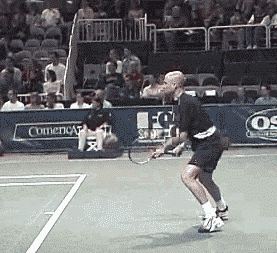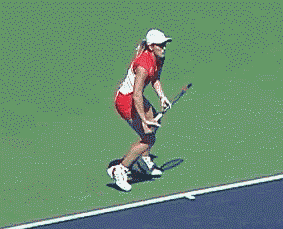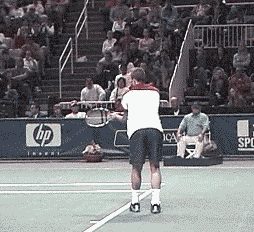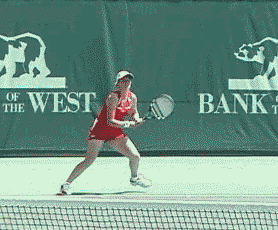|
TennisOne Lessons
The Essentials of Shot Making by Feisal Hassan, USPTA Master Professional Ready position. Grip. Backswing. Contact point. Follow-through. These are the stroke components that have been drilled into us when taking tennis lessons. And they are important components of shot making, but, what are the true essentials that lead to a successful tennis stroke? It is my belief that seeing /watching the ball, moving to the ball, maintaining balance when hitting the ball and controlling the racquet head are the real fundamentals. For decades, players have been told to "watch the ball," "move your feet," "keep your balance," and "control the racquet or swing." These phrases seem to be maxims that should solve all of the sensory problems encountered when playing tennis. And these phrases are fine if the purpose is to make the student aware of what it is he/she needs to fix. But how does one learn to "watch" the ball better or maintain their "balance during a stroke?" It's like telling someone to concentrate. Saying concentrate isn't going to make one concentrate. A player needs to be taught how to concentrate. In the same way, a player needs to be taught how to: watch the ball, move the feet, maintain balance, and control the racquet.
Thus, I believe the essentials of shot making can be broken down into four stages:
These stages are realistic to the sequence of what a player has to go through when hitting a ball. The purpose of this article is to demonstrate the method/program that I use to train these essentials of stroke making utilizing specific training programs for each stage. Future articles will go in-depth and offer practice drills and exercises for each level within each of the 4 stages of shot making. Stage 1: VisionOur body can only respond to what it can see. Despite this fact, I feel much too little attention is paid to vision. By undertaking a simple visual training program, a tennis player can improve his/her performance. That's because the eyes, like the muscles in our bodies, can be strengthened to perform better with exercise. By seeing better, you can play better because what and how you see, is what and how you will do. My vision-training program involves sets of exercises broken down into six levels: Level 1: Head Positioning - Purpose: To help players identify and feel the head positioning during strokes. Level 2: Dynamic Visual Acuity - Purpose: To help see the ball more effectively and efficiently while the player and the ball are moving . Level 3: Eye Tracking Exercises - Purpose: To develop the ability to follow a moving object smoothly and accurately with both eyes. Level 4: Eye Teaming & Depth Perception - Purpose: To develop the ability to use both eyes together (in unison), to judge relative distances of objects and to see and move accurately in three-dimensional space. Level 5: Peripheral Vision - Purpose: To develop the ability to maintain and interpret what is happening on the court (in your side vision) while attending to the ball (the specific central vision). Level 6: Eye-hand Coordination - Purpose: To effectively develop how one's visual system guides their motor system. After vision skills are trained, movement skills need to be addressed.
Stage 2: MovementTennis is a game of movement and a game of emergencies and should be trained as such. In tennis, it's not necessarily how fast you are, but how fast you are relative to the ball. By undertaking a simple tennis specific movement-training program, a tennis player can improve his/her performance by moving around the court faster and and more efficiently. My tennis specific movement-training program involves sets of exercises broken down into five levels: Level 1: Improving Foot Speed - Purpose: To develop a player's speed. Level 2: Agility - Purpose: To train a player to change directions with the least amount of speed loss. Level 3: Changing Footwork Patterns - Purpose: To train a player to change from one footwork pattern to another rapidly. Level 4: Speed Endurance - P urpose: To train a player to repeatedly perform maximum or near maximum bursts of energy required for an entire match. L evel 5: Movement Techniques for Shots in Different Parts of the Court - Purpose: To train a player the movement techniques required for shots in different parts of the court by knowing the efficient and effective ways to move. Stage 3: BalanceOne of the most important things in becoming a good tennis player is to be in the correct position to hit the ball. Not only does one's footwork have to be efficient to be able to get to the ball, but one has to maintain balance once he/she gets there. Therefore, a player needs to learn to master and control his/her body.
Usually reasons such as hitting the ball too close or too far away from the body, bad elbow position, too high shoulders, etc. Are given; when the real cause of these problems may be as simple as loss of balance. Players are constantly told to maintain their balance but for most, that is easier said than done. These players must be trained on how to achieve this state of balance. By undertaking a simple balance-training program, a player will become more aware of their head, upper body and leg positions during the stroke. My balance-training program involves sets of exercises broken down into four levels: Level 1: Head Position - Purpose: To help players identify and feel the head position during strokes. Level 2: Upper Body Position - Purpose: To help players identify and feel the upper body position during the stroke. Level 3: Leg position - Purpose: To help players identify and feel the leg position during strokes. L evel 4: Stroke-specific Balance Exercises - Purpose: To develop a player's neuromuscular control and improve a player's state of equilibrium for specific strokes. Stage 4: Swing ControlThe final stage of stroke making is the control of the racquet head during the stroke. With the increase in the speed of the game and racquet technology, the training of racquet acceleration has become essential for a player's success.
Where does racquet acceleration fit into stroke fundamentals? The problem players and coaches are faced with is that an increase in racquet-head speed can easily lead to a decrease in control, negatively affecting a player's game. The racquet acceleration and control training program involves the following set of exercises broken down into four levels: Level 1: Relaxation and Swing Development - Purpose: To help players identify and feel which muscles are really used in swinging and which muscles need to be relaxed. Level 2: Pure Acceleration - Purpose: To develop the motor ability to swing fast. Level 3: Combination Exercises - Purpose: To emphasize that acceleration and control are equally important. Level 4: Pure Control Exercises - Purpose: To increase control during the stroke. The purpose of this article was to introduce you to a method on how to train the seeing, moving, balance, and racquet head skills required for stroke making utilizing training programs for each stage. Future articles with take a closer look at each stage and demonstrate drills and exercises to train the essentials of shot making. Your comments are welcome. Let us know what you think about Feisal Hassan 's article by emailing us here at TennisONE
|





 Feisal Hassan, a USPTA Master Professional and PTR certified professional, is a member of the Head/Penn Racquet Sports National Advisory Board and National Speaker's Bureau, the Director of Certification & Testing for the USPTA Middle States division and a USA High Performance Coach.
Feisal Hassan, a USPTA Master Professional and PTR certified professional, is a member of the Head/Penn Racquet Sports National Advisory Board and National Speaker's Bureau, the Director of Certification & Testing for the USPTA Middle States division and a USA High Performance Coach.